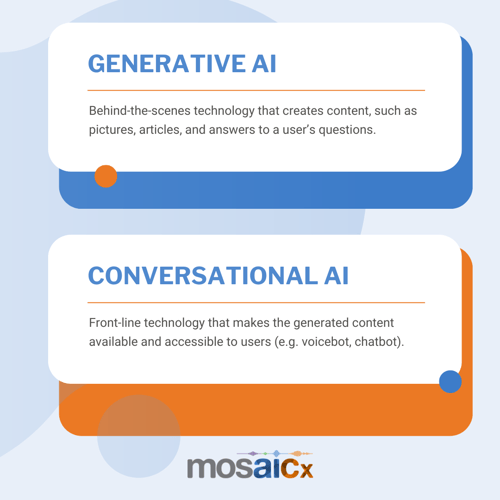12 Call Center Metrics You Should Be Using to Improve CX in 2025
Call center metrics are the most important performance indicators that monitor how effectively your call center is running. This includes anything...
Customer service is rapidly changing thanks to artificial intelligence (AI) advances. Two types of AI that are having a major impact are generative AI and conversational AI. Each offers distinct capabilities that can greatly improve customer support when applied properly.
The difference between generative AI and conversational AI can be understood in how they are used. Generative AI creates content, while conversational AI responds and communicates in a natural, human-like way.
In the following article, we will see what each entails, their differences, and how they can work together to elevate the customer experience.
Generative AI refers to AI systems that generate new content, data, code, and more from scratch. Unlike most AI which is focused on analysis or classification, generative AI can autonomously create materials without simply reconfiguring existing content.
Prominent examples of generative AI include systems like DALL-E which can generate images from text descriptions, GitHub Copilot which suggests new code based on comments, and systems like Anthropic’s Claude which can generate lengthy texts on a wide variety of topics. These systems utilize machine learning techniques like deep learning to produce outputs that mimic human-quality work.
In customer service, generative AI has powerful implications. Potential use cases include:
Overall, generative AI allows agents to scale their productivity by offloading repetitive, pattern-driven work. This lets them focus on truly complex interactions.
Conversational AI refers to AI systems designed to understand natural human language and carry on helpful dialogues. Key examples include chatbots and voice assistants that can interpret customer questions and provide relevant answers.
These tools utilize natural language processing (NLP) to analyze text conversations. Some key capabilities include:
In customer service, conversational AI takes over routine customer inquiries, reducing human agents’ workload. Common applications include:
These tools save substantial time by resolving common issues instantly without needing human input. They also give agents flexibility to step in for inquiries that are too complex.

Proper integration is only possible after knowing the differences between Generative AI and Conversational AI. While they have different goals and uses, the main difference lies in how they take input. Conversational AI understands and responds to real-time human conversations. Generative AI generates content in various forms based on a diverse data type. This primary divergence also highlights their core functionality where conversational AI focuses on interactive human-like communications using the user's natural language, and generative AI creates unique content to showcase its creative capabilities.
When delving into uses, conversational AI works best for customer service, virtual assistants, or learning applications where human likeness plays an important role. Generative AI, on the other hand, is exceptional in content creation. It boosts innovation by crafting images, producing music, writing works of fiction, generating meta descriptions, and other similar feats to enrich the user's (artist's) expression.
The table below highlights some more differences between the two AI-powered technologies before we jump into some real-world examples.
Here are some real-world examples of companies already using generative AI to improve customer service:
For software issues tracked in GitHub, Copilot can suggest autoclosing stale issues by generating notes explaining why issues are obsolete. This saves engineers time.
The online sneaker marketplace uses generative AI to draft catchy product descriptions optimized for search based only on structured product data.
Amazon Web Services leverages generative models trained on past documentation to produce first-draft cloud service descriptions for engineers to refine.
Stripe is piloting GitHub Copilot to generate repetitive code for workflows like issuing refunds. This boosts developer productivity.
This customer service platform generates classifications for incoming tickets to instantly route issues to the right agents according to predicted topic and urgency.
As these examples illustrate, generative AI is gaining real traction in streamlining all areas of customer service. Companies like Mosaicx are working to expand generative AI to front-line customer service.
People are excited about generative AI, but there is still fear that it may give customers inaccurate or unfavorable information. Mosaicx is working to create solutions with "guardrails." Essentially, tools that answer FAQs while using an approved database of information, not the entire internet. This allows virtual agents to give personalized information to customers while maintaining brand standards and reputation.
Related: 20 Examples of Generative AI Customer Service
Leading companies have also integrated smart conversational AI to allow efficient self-service issue resolution. Here are some examples:
Alaska Airlines uses AI to optimize air traffic flow, but they also employ a virtual agent that sounds a lot like a human agent. It asks questions, speaks naturally, and can complete common tasks like checking flight status.
Subscriber recommendation chatbots initiate millions of 1-on-1 conversations monthly to suggest personalized, relevant titles.
In messaging channels, Spotify conversational assistants suggest playlists and music based on listeners' tastes using advanced machine learning algorithms.
As these examples show, conversational AI has become pivotal to scaling great service. Natural dialogue keeps resolution seamless while offloading agents for higher-value tasks.
While generative and conversational AI each offer distinct strengths, they work best together in customer service. Popular tools like Google Bard and ChatGPT are known for generative AI, but they actually use both. Within a chat-based interface, these tools accept input and communicate in a natural way. That aspect of the experience is powered by conversational AI.
Here are more powerful ways they can integrate:
Frontline conversational bots can generate better answers on the fly by calling backend generative models to produce custom content for unique cases and topics.
Smart conversational assistants analyze inbound ticket data and then assign issues to specialized generative models capable of producing solutions.
Agents can save vast amounts of time by having AI draft comprehensive responses to unusual or complex inquiries which teams can then finalize.
Conversational agents can pull from databases of generated articles to address a wider range of customer questions with individualized answers.
As these examples illustrate, weaving conversational and generative together amplifies the strengths of both approaches. Bots handle high-volume routine interactions while generative backbends create tailored solutions to unique cases.
Over time, more customer service platforms will seamlessly integrate these capabilities. This will reduce response times, automate more complex exchanges, and deliver support experiences that feel personalized through AI working together behind the scenes.
Conversational AI and generative AI are highly expected to play pivotal roles in shaping a smart business world. Conversational AI, for starters, is becoming more context-aware to even detect varying emotional states for enhanced customer interactions and experiences.
Generative AI is similarly evolving to redefine creativity across all mediums. In addition to allowing everyone to have an artistic expression, market professionals can improve their innovation and productivity by automating their creation process. Whether that includes product descriptions, graphic designs, email generations, or social media content, generative AI is expected to reshape how marketing agencies do business in the future.
Alongside benefits, the advances in AI also bring to light unique, ethical considerations based on their design and uses. Since conversational AI is engineered to learn from customer interactions, it must ensure fair treatment. There should be no bias in its responses. Secondly, conversational AI records customer data to provide tailored follow-ups. Ensuring privacy protection is another ethical consideration for businesses. Their customer data should not be misused or sold to third-party data-collection entities.
Generative AI suffers from privacy concerns as well. The ability to generate content must have a failsafe to avoid providing misleading information. The problem of "deepfakes" is a prominent example. Creating fake images and videos of real-world people is akin to deceptive media, which can hurt people and businesses. It is important from an ethical standing that generative AI finds a middle ground between expressing creativity and sticking with the truth.
Customer service is being revolutionized by artificial intelligence. With innovations in conversational AI, companies can scale interactive support on websites, apps, and popular messaging platforms. Meanwhile, generative AI can create helpful, tailored content for each client.
As these technologies mature, generative and conversational AI will blend to deliver swift, satisfying issue resolution using whichever mode customers prefer. Adoption is just beginning. AI will transform customer service to be highly individualized yet effortlessly scalable.
We expect to see some big progress on this front in 2024. Now is a good time to prepare by learning about new ways to use AI in customer service in the next year.
Mosaicx has a long history of using conversational and generative AI to enhance customer experiences across multiple industries. That covers streamlining telecom resolutions, securing financial transactions, booking five-star holiday travels, providing reliable insurance recommendations, driving retail sales and customer interactions, and more.
From leveraging intelligent virtual agents (IVAs) to carry out natural-sounding conversations to using voice recognition and speech patterns to help customers find information quickly, Mosaicx provides AI-powered tailored solutions to reduce your business’ workload and errors while improving productivity and sales.
If you are ready, consider scheduling a demo to experience how Mosaicx can use conversational and generative AI to make your business smarter.

Call center metrics are the most important performance indicators that monitor how effectively your call center is running. This includes anything...

Businesses across industries have changed or evolved over the decades, but one thing that has remained the same is that their growth is pretty much...

Customers have several major expectations from modern businesses, but none is as challenging as them reading your mind to anticipate support you...
